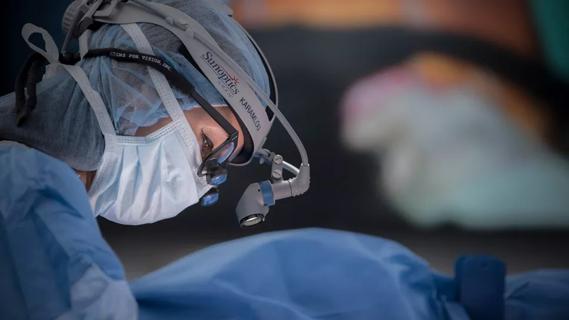Several factors identified that may reduce the need for open-heart surgery in some infants

A first-of-its-kind study has identified factors associated with a second pulmonary conduit replacement that may reduce the need for a third open heart surgical procedure in pediatric congenital heart disease patients.
Advertisement
Cleveland Clinic is a non-profit academic medical center. Advertising on our site helps support our mission. We do not endorse non-Cleveland Clinic products or services. Policy
Infants born with conditions such as truncus arteriosus, pulmonary atresia with ventricular septal defect, or tetralogy of Fallot with pulmonary atresia, typically require a right ventricle to pulmonary artery conduit (PC) as part of their initial surgical repair. These PCs will require surgical replacement as the child grows. Previous studies from the multicenter Congenital Heart Surgeons’ Society (CHSS) cohort have identified factors associated with longevity of the initial valved PC placement (PC1), including use of a bovine jugular venous valved conduit and a smaller (or larger) PC1 z-score.
Now, in the same patient cohort, CHSS has for the first time prospectively investigated factors associated with PC2 that predict the timing and need for a subsequent surgical third conduit (PC3) placement versus a less-invasive transcatheter pulmonary valve insertion (PCVI) into the PC2. Here, in contrast to the PC1 findings, use of a larger PC2 in the context of available anatomic space was associated with a lower time-related risk for PC3, along with delaying PC2 to an older age and avoiding aortic allografts.
“What we do in babies when we put in that second conduit is critical because that conduit will hopefully be the last open heart surgery that child might need if we set it up properly,” says Tara Karamlou, MD, a pediatric cardiothoracic surgeon at Cleveland Clinic and a CHSS member.
The PC size finding is key, she says. “In the earlier study we found that oversizing was just as bad as undersizing. But that was in small babies less than age 2 years. With PC2 they’re older children so it’s feasible to put in a larger valve without the risk of sternal compression, and now these new findings suggest it’s optimal in that it could set the child up for a subsequent PCVI rather than a third open-heart surgery.”
Advertisement
The study involved 630 patients who underwent PC1 before 2 years of age and were prospectively enrolled from 29 CHSS member institutions in the US and Canada. Of those, 355 underwent surgical explant and replacement of the initial PC (PC2). In that group, the most common underlying diagnosis was truncus arteriosus (44%) and the most common PC2 type was pulmonary allograft (34%).
Over a median follow-up of 5.3 years, 65 received a surgical PC3 replacement, 41 underwent TPVI, and 10 died, while the rest remained alive with PC2 still in place.
While a higher PC1 Z-score was associated with an increased risk for PC3 (hazard ratio 1.23, P = .043 per 1 unit), a higher PC2 Z-score lowered it (0.62, P <.001 per 1 unit). Other significant PC2 predictors of surgical PC3 replacement were older age at PC2 (0.72, P <.001 per year) concomitant aortic valve intervention (7.57, P = .009), and aortic allograft (2.17, p – .008).
Factors at PC2 associated with time-related TPVI insertion were older age (2.34, P =.01), aortic allograft (3.25, P = .006), and porcine unstented conduit (4.66, P < .001).
Dr. Karamlou urges caution in interpreting the negative finding for aortic allografts, which had also been observed in the prior CHSS studies. Although aortic allografts have a greater likelihood of calcification, stenosis, or regurgitation, they are often selected for the smallest infants and those with adverse downstream pulmonary artery architecture and higher pulmonary vascular resistance.
“So, I think the babies who had aortic allografts were getting those for reasons that aren’t really modifiable. I don’t think it’s the aortic allograft, but more the patient population,” Dr. Karamlou says, noting that this is a particularly important consideration since aortic allografts may be the only option at some centers.
Advertisement
Dr. Karamlou anticipates that these new findings, combined with the prior two studies from this cohort published in 2006, will inform the development of guidelines for pediatric congenital heart defect repair. Currently there are only guidelines for adults since large, multicenter, prospective pediatric data had not been available prior to this CHSS effort.
While the need for oversizing PC2 appears clear, optimizing the timing in pediatric cases still needs to be worked out. “Timing of these is critical. We know that if we wait too long the right ventricle can suffer. We’ve established some benchmarks in adults where we use MRI criteria to gauge when we need to change the conduits. In pediatrics that doesn’t exist because their hearts are much smaller and right ventricular remodeling may involve both pressure and volume load,” she notes.
The study is coordinated by the CHSS Data Center, a combined research and quality endeavor that is now housed jointly at the Cleveland Clinic and the Hospital for Sick Children in Toronto. Notes Dr. Karamlou, who was an author on all three of the papers in the series, “Cleveland Clinic is intensely involved in the operationalization of these studies.”
Advertisement
Advertisement

A reliable and reproducible alternative to conventional reimplantation and coronary unroofing

Case provides proof of concept, prevents need for future heart transplant

Proof-of-concept study finds technology improves quantitative evaluation of blood flow characteristics

Study examines data and clinical implications for performing Ross procedures in infancy versus later in life

Expert panel advises a two-tier structure for surgical centers

Case is first of its kind to obviate heart transplant successfully

New findings on aortic root position and features may lead to safer valvar surgery

Surgeons reassured by low risk of harm